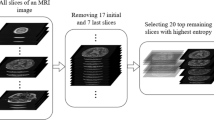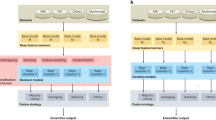Abstract
The utmost popular dementia cause is because the (AD) Alzheimer’s disease. A continuous drop in mental ability is referred to as Dementia. Using the medical images of the brain, the developmental stages of AD symptom of neuropsychiatric functionality are analyzed often. Particularly in the area of classification and detection, cutting edge technologies which comprise computer algorithms, have been used for Alzheimer’s disease diagnosis treatments. To improve prediction on new data, ensemble learning applies a group of decision-making systems that uses different strategies to unite classifiers. This paper uses the combination of (DCNN) and deep ensemble learning, i.e., MobileNetV2 and LSTM using magnetic resonance images (MRI). The ADNI dataset is used for the dementia stages classification. Compared to CNN, Deep Ensemble Learning (DEL) performs better. For the evaluation, six metrics were used; accuracy, the area under the curve (AUC), F1- score, precision, recall and computational time. In addition, the calculation for specificity and sensitivity is evaluated for the performance enhancement, which shows the exact affected area. A sensitivity of 94% and a specificity of 95% are obtained in the classification, respectively.





Similar content being viewed by others
Data availability
Not applicable.
References
Lee, G., Nho, K., Kang, B., Sohn, K.A., Kim, D.: Predicting Alzheimer’s disease progression using multi-modal deep learning approach. Sci. Rep. 9(1), 1–12 (2019)
Bi, X., Wang, H.: Early Alzheimer’s disease diagnosis based on EEG spectral images using deep learning. Neural Netw. 114, 119–135 (2019)
Qiu, S., Joshi, P.S., Miller, M.I., Xue, C., Zhou, X., Karjadi, C., Kolachalama, V.B.: Development and validation of an interpretable deep learning framework for Alzheimer’s disease classification. Brain 143(6), 1920–1933 (2020)
Duc, N.T., Ryu, S., Qureshi, M.N.I., Choi, M., Lee, K.H., Lee, B.: 3D-deep learning based automatic diagnosis of Alzheimer’s disease with joint MMSE prediction using resting-state fMRI. Neuroinformatics 18(1), 71–86 (2020)
Choi, H., Kim, Y.K., Yoon, E.J., Lee, J.-Y., Lee, D.S.: Cognitive signature of brain FDG PET based on deep learning: domain transfer from Alzheimer’s disease to Parkinson’s disease. Eur. J. Nucl. Med. Mol. Imag. 47(2), 403–412 (2020)
Raju, M., et al.: Multi-class diagnosis of Alzheimer’s disease using cascaded three dimensional-convolutional neural network. Phys. Eng. Sci. Med. 43(4), 1219–1228 (2020)
Gautam, R., Sharma, M.: Prevalence and diagnosis of neurological disorders using different deep learning techniques: a meta-analysis. J. Med. Syst. 44(2), 1–24 (2020)
Puente-Castro, A., et al.: Automatic assessment of Alzheimer’s disease diagnosis based on deep learning techniques. Comput. Biol. Med. 120, 103764 (2020)
Acharya, U.R., Fernandes, S.L., WeiKoh, J.E., Ciaccio, E.J., Fabell, M.K.M., Tanik, U.J., Yeong, C.H.: Automated detection of Alzheimer’s disease using brain MRI images–a study with various feature extraction techniques. J. Med. Syst. 43(9), 1–14 (2019)
Liu, M., Cheng, D., Wang, K., Wang, Y.: Multi-modality cascaded convolutional neural networks for Alzheimer’s disease diagnosis. Neuroinformatics 16(3), 295–308 (2018)
Sivaranjini, S., Sujatha, C.M.: Deep learning based diagnosis of Parkinson’s disease using convolutional neural network. Multimed. Tools Appl. 79(21), 15467–15479 (2020)
Tufail, A.B., Ma, Y.-K., Zhang, Q.-N.: Binary classification of Alzheimer’s disease using sMRI imaging modality and deep learning. J. Digit. Imag. 33(5), 1073–1090 (2020)
Vu, T.D., Ho, N.H., Yang, H.J., Kim, J., Song, H.C.: Non-white matter tissue extraction and deep convolutional neural network for Alzheimer’s disease detection. Soft. Comput. 22(20), 6825–6833 (2018)
Son, H.J., Oh, J.S., Oh, M., Kim, S.J., Lee, J.H., Roh, J.H., Kim, J.S.: The clinical feasibility of deep learning-based classification of amyloid PET images in visually equivocal cases. Eur. J. Nucl. Med. Mol. Imag. 47(2), 332–341 (2020)
Sun, J., Yan, S., Song, C., Han, B.: Dual-functional neural network for bilateral hippocampi segmentation and diagnosis of Alzheimer’s disease. Int. J. Comput. Assist. Radiol. Surg. 15(3), 445–455 (2020)
Oh, K., et al.: Classification and visualization of Alzheimer’s disease using volumetric convolutional neural network and transfer learning. Sci. Rep. 9(1), 1–16 (2019)
Qiao, J., et al.: Multivariate deep learning classification of Alzheimer’s disease based on hierarchical partner matching independent component analysis. Front. Aging Neurosci. 10, 417 (2018)
Choi, H., et al.: Cognitive signature of brain FDG PET based on deep learning: domain transfer from Alzheimer’s disease to Parkinson’s disease. Eur. J. Nucl. Med. Mol. Imag. 47(2), 403–412 (2020)
Mendoza-Léon, R., et al.: Single-slice Alzheimer’s disease classification and disease regional analysis with supervised switching autoencoders. Comput. Biol. Med. 116, 103527 (2020)
Choi, B.K., Madusanka, N., Choi, H.K., So, J.H., Kim, C.H., Park, H.G., Prakash, D.: Convolutional neural network-based mr image analysis for Alzheimer’s disease classification. Current Med. Imag. 16(1), 27–35 (2020)
Ramzan, F., et al.: A deep learning approach for automated diagnosis and multi-class classification of Alzheimer’s disease stages using resting-state fMRI and residual neural networks. J. Med. Syst. 44(2), 1–16 (2020)
Wang, S.-H., et al.: Classification of Alzheimer’s disease based on eight-layer convolutional neural network with leaky rectified linear unit and max pooling. J. Med. Syst. 42(5), 1–11 (2018)
Baskaran, K.R., Sanjay, V.: Deep learning based early Diagnosis of Alzheimer’s disease using Semi Supervised GAN. Ann. Romanian Soc. Cell Biol. 1, 7391–7400 (2021)
Acknowledgements
We declare that this manuscript is original, has not been published before and is not currently being considered for publication elsewhere.
Funding
Not applicable.
Author information
Authors and Affiliations
Contributions
The author confirms sole responsibility for the following: study conception and design, data collection, analysis and interpretation of results, and manuscript preparation.
Corresponding author
Ethics declarations
Conflict of interests
The authors declare that they have no known competing financial interests or personal relationships that could have appeared to influence the work reported in this paper.
Ethical approval
This material is the authors’ own original work, which has not been previously published elsewhere. The paper reflects the authors’ own research and analysis in a truthful and complete manner.
Additional information
Publisher's Note
Springer Nature remains neutral with regard to jurisdictional claims in published maps and institutional affiliations.
Rights and permissions
Springer Nature or its licensor (e.g. a society or other partner) holds exclusive rights to this article under a publishing agreement with the author(s) or other rightsholder(s); author self-archiving of the accepted manuscript version of this article is solely governed by the terms of such publishing agreement and applicable law.
About this article
Cite this article
Rajesh Khanna, M. Multi-level classification of Alzheimer disease using DCNN and ensemble deep learning techniques. SIViP 17, 3603–3611 (2023). https://doi.org/10.1007/s11760-023-02586-z
Received:
Revised:
Accepted:
Published:
Issue Date:
DOI: https://doi.org/10.1007/s11760-023-02586-z




